Last Chance to Catch NYC's Holiday Notalgia Train
We met the voices of the NYC subway on our nostalgia ride this weekend!


It seems like every week, networks are releasing outlandish and gimmicky food shows that continually try to top the latest one. However, in PBS’ Roadfood host Misha Collins is taking fans back to the basics of exploring American cuisine. Collins brings fans along for the ride on a rich culinary experience that deep dives into the cuisines of areas in the United States with robust communities and culture. Collins hones in on locations and communities that may not be the first thing that comes to mind when someone mentions a city. Yet rather than focusing on on the best pizza places in New York or barbeque in Texas, Roadfood takes fans on a deeper ride through these cities and the wonderfully diverse food, culture, and people who live there. New Yorkers will be most excited to dive into the show’s second episode, titled “NYC/Little Dominican Republic: Tres Golpes.” As Collins said, “This feels like a city within a city.”
Collins’ charm and wit shine through the series almost as much as his genuine compassion, eagerness to listen to people’s stories, and drive to shed light on injustices within these communities. The actor, perhaps most renown for Supernatural, turned what could have been a simple food tasting show into a thoughtful and well-rounded program that’s more about people and community than the food they celebrate. The culinary aspect of the series is certainly entertaining. Still, the series’ heart comes out the strongest when Collins interviews community leaders and culinary experts about their journey to success and the struggles many of these communities still face today.

Roadfood expertly balances the show’s humor with its depth, offering 25 minutes of complete immersion into a city and its cuisine during each episode, even inspiring fans to get involved with their own communities and activism along the way. One miss is that the show does not label each new restaurant the Roadfood team visits, which would have made it easier for fans to patronize the establishments without having to don their Nancy Drew goggles to figure out where the crew stopped. Untapped New York will step in here, and provide you a guide to the hidden food gems in the Washington Heights area.
New Yorkers will be most excited to dive into the show’s second episode, titled “NYC/Little Dominican Republic: Tres Golpes.” As Collins said, “This feels like a city within a city.” Using the New York episode as a guide, here are some hidden gems in the Washington Heights area.
Collins is no stranger to New York City, but community activist Juan Rosa introduced him to an aspect of the city he hadn’t noticed before. Collins remarked during the episode, “I’ve visited New York a million times. I have driven past here and just had my blinders up, and I haven’t allowed myself to explore, experience, and talk to people, and I feel like I am learning so much about how culture can be and how we could interact with one another.” That’s what Roadfood does best: unveil elements of a city you may see every day without ever truly seeing or experiencing what these areas have to offer.
Collins asked Rosa, “What do you want the world to know about this place? And is there some sort of wisdom that this community can convey to the rest of America?” He said, “The community wants you to know that once you come into the neighborhood, you are a part of the family.” He mentioned the area’s community values in that everyone is friendly and greets each other, adding, “I think New York City missed that. Everyone misses smiling at each other and making that connection with strangers. Little Dominican Republic, Washington Heights, Dyckman, you will find that. The family, the love, and great food. It makes me proud to be Dominican.” In Little Dominica, food and family go hand in hand, and there are a whole lot of cultural cuisines to feast on in the area.
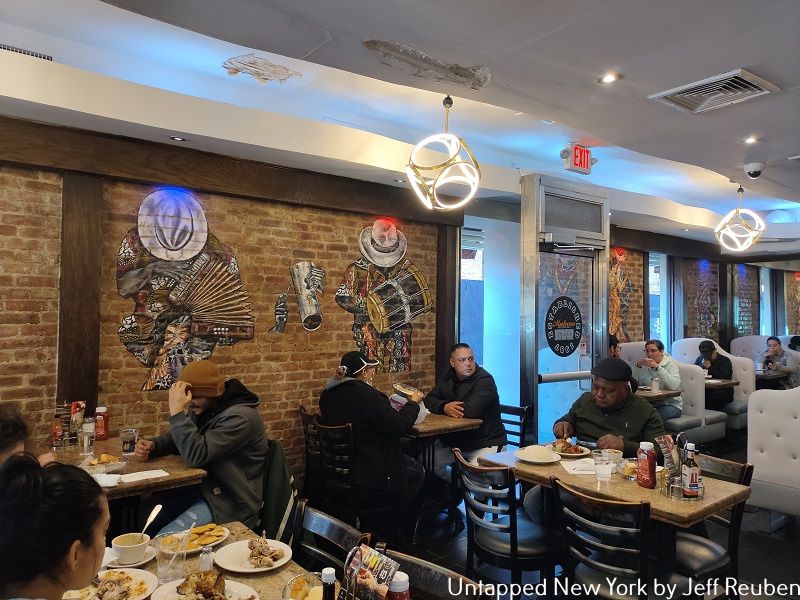
The first stop on the Roadfood tour through Washington Heights is Malecón Restaurant, where Collins and Rosa settled down for some Dominican-Caribbean breakfast. The menu boasts classics like habichuelas con dulce, pide lo tuyos, and mofongo de langosta en salsa roja.
However, Collins noted how much Rosa loves Dominican breakfast, so they ordered tres golpes. Rosa explained that the morning dish translates to “three hits.” Of course, like any morning food, the cheese, fried egg, salami, and mangu (mashed plantains) plate is all about providing a jolt of energy. When Collins asked Rosa how often he eats this particular item, he said, “As often as I can.”
The duo took this opportunity to get into the deeper subject of Little Dominica’s future. Collins asked, “Do you think that Little Dominica will be Little Dominica 15 years from now?” Rosa confirmed that he thinks it will, adding, “[The] cultural impact that this community has in the broader culture I think makes it so that it’s not gonna be erased. I think we over here in Little Dominican Republic, we hold on to our traditions — because we’re not in the every day of our homeland. We have to keep onto our traditions that remind us of that homeland.”

What’s a morning adventure without a little sweetness? If the tres golpes isn’t doing enough to put a jolt in someone’s day, it’s time to find some coffee. When it comes to Washington Heights, bakeries are a go-to spot for some of the best cafė hits. On top of Dominican cakes, the Dios Proveedor Bakery serves cafė con leche: a Spanish and Latin American drink that’s one-part coffee and one-part scalded milk. However, if you ask Collins, he’ll tell you that it’s more sugar than anything.
When Rosa asked how much sugar Collins wanted in his cafė con leche, the actor told him “the appropriate amount” because he usually doesn’t add sugar to his coffee. As it turns out, the “appropriate” amount is much too sweet for Collins’ blood. He joked, “One ladle of sugar? Is that what I got?” So maybe skip the sugar if your sweet tooth isn’t as refined as Rosa’s. But according to Rosa, you might get side-eyed for that particular choice.
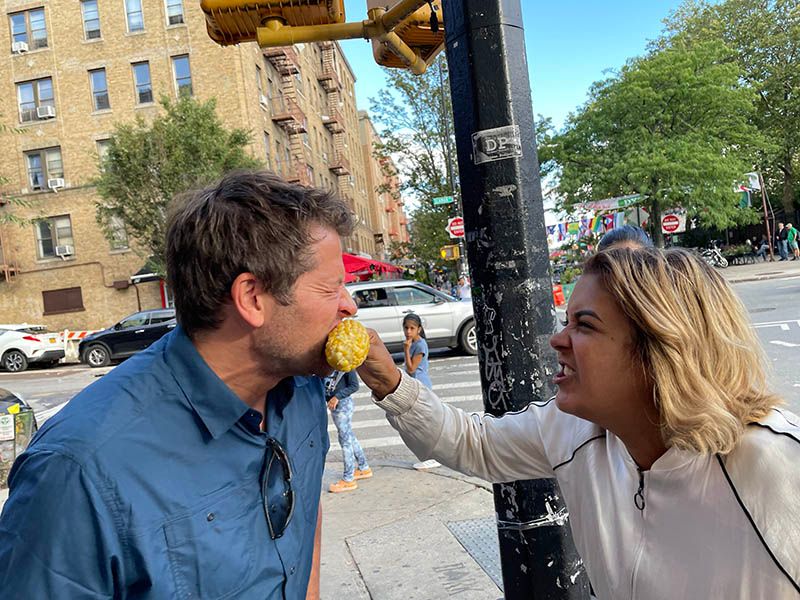
Not every iconic eatery needs a brick-and-mortar building to be world-famous — especially in Washington Heights. The area is bustling with endless street vendors and stands that offer a range of fresh fruit, vegetables, and Dominican classics. One such vendor is Nidia Rivera, whose habicheulas con dulces stand attracts patrons from all over the world. In the simplest terms, the dish consists of beans that are cooked with some dairy and sweetened.
When Collins and Rosa visited Rivera’s stand, her granddaughter said, “People coming from Miami, to take this. Atlantic City, from Boston — everywhere.” Collins asked why hers is so famous, and she replied, “My grandma been here for 30 years.” Given that Rivera’s recipe includes cookies, Collins said, “It’s almost like a hot chocolate.” With a scandalized expression, Rosa said, “It’s a lack of justice.” Collins clarified, “It’s great — unlike anything I’ve ever had.”
Despite being a street stand, Rivera’s operation is no small enterprise. Fans can see the 11 huge orange Home Depot coolers of product by the stand, and Rosa noted that they go through about 20 of them a day. Collins tries both the sweet beans and sweet corn habichuelas con dulces options the stand offers, but he likes the beans better than the corn.
Rosa also noted that vendors have feuds on whether or not raisins should be included in the dish. Raisin connoisseur Collins said, “Oh, definitely raisins. I’m staunchly pro-raisin myself.” Rosa translated a worker’s explanation, saying, “They don’t put the raisins in because people come from all over to get the habichuelos. So in order to preserve them, it’s better not to put the raisins. It makes them sour.” So fans will just have to decide for themselves which version they prefer.
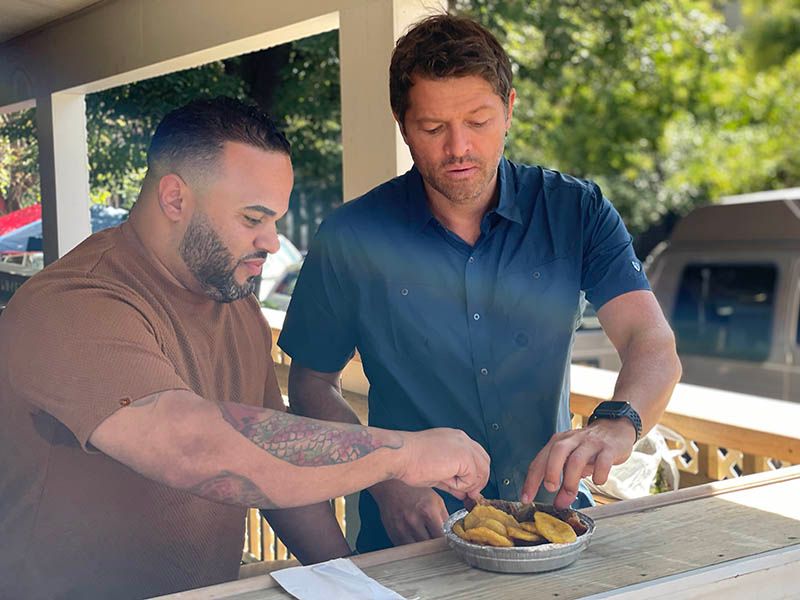
After the stand, Collins met up with chef Kelvin Fernandez and they hit up a produce stand to try quenepas, also known as limoncillos — a Spanish lime. Later, they headed to La Reina Del Chicharrón, which Fernandez translated to “The Queen of Chicharrón.” Fernandez quipped, “There’s a reason they call it Little Dominican Republic. This is where you can find all the great food.” But it’s not only the locals who head to the area for great food. When Collins and Fernandez entered the restaurant, a customer from New Jersey explained that he came to La Reina Del Chicharrón for the “best chicharrón.” Collins asked a worker what makes it the best, and he said, “Oh, the flavor and the crunch is the best. No one else has the same chicharrón.”
So, what exactly is chicharrón? The worker explained that it’s made from the ribs of pork and chopped up. Then, the restaurant deep-fries it before it’s brined in their marinade. He noted that it’s traditionally served with plátanos fritos (green fried plantains). Collins joked that you should “Come here when you’ve decided to stop working out altogether.”
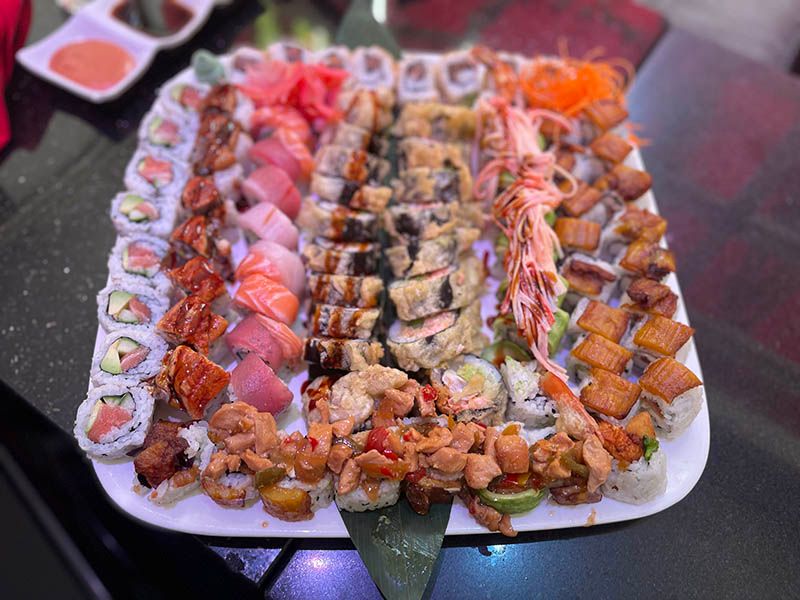
Collins and Fernandez then met up with Susan Osorio, the co-founder of Mamajuana, MamaSushi, and a slew of other Little Dominica restaurants. Collins said, “She seems to be the queen of Little Dominica.” That certainly seemed like the case as she enthusiastically greeted most passersby by name.
First, Collins and Osorio went to MamaSushi, where the owner explained what sets the restaurant apart from its competitors. “It’s the ingredients in MamaSushi that make us different. We use a lot of Spanish ingredients. You got to eat a sushi with pork, beef, bacon, chicken. It’s either fried, grilled, or pan-fried.”
Osorio introduced Collins to the dish la chapiadora, which she noted means a famous, beautiful girl who goes into a restaurant who wants to ask, “What’s the most expensive item on the menu?” According to Osorio, “It’s like a chicken teriyaki on top. You’re gonna love it.”
The business owner went through her family history, noting that she came to the States at 15 and that her mother has been here since 1978. Osorio added, “That’s the good thing about Mama Sushi. That’s it. It’s a little bit for everyone. And we put a lot of passion and love in what we do.” Collins responded with, “I can tell.”
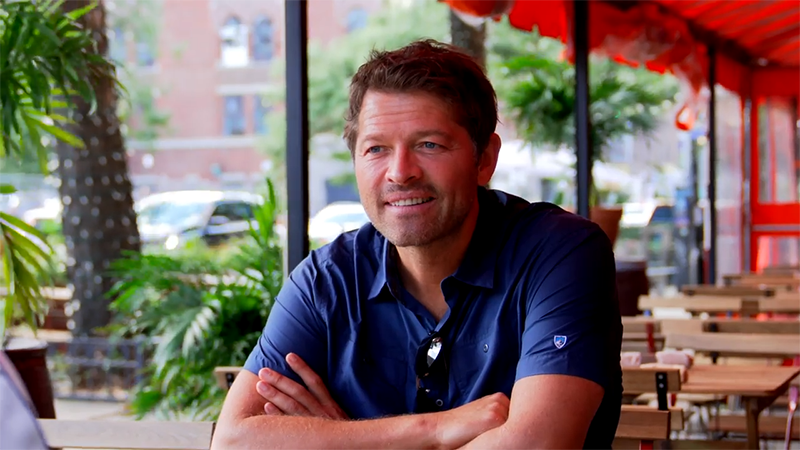
Luckily for patrons who don’t like to walk much in between restaurant hot spots, Osorio’s restaurant Mamajuana is located next door to MamaSushi. She gave credit to her brother and ex-husband, who started the restaurant with her before Collins said, “You work hard.” Osorio responded, “I was born as a businesswoman. I used to cook when I was ten years old. I used to take all of them and put onions. Garlic, cilantro, and all that, and I used to cook for my brother and my sister. I love to cook.” Mamajuana serves staples like salads, steak, and house specials like pargo relleno and puerquito — on top of pasta and a range of seafood options.
Between all of her restaurants, Osorio has about 30 employees who are also members of her family — making her struggles during the pandemic extra hard. Imagine being responsible for businesses that employ that many family members and having it threatened by something as unpredictable as a pandemic. Luckily, Osorio rallied, but it wasn’t easy. She said, “I thought that everything was falling apart. I get kind of sensitive when I talk about that.” She even had to do deliveries herself, but in the end, both restaurants made it.
After the restaurant sit-downs, Osorio led Collins and Fernandez through a walk of her neighborhood. In response to her knowing the entire neighborhood by name, Collins remarked, “I’m thinking about how incredibly different this is from the community that I grew up in. I was brought up in this small town where the most we would ever do to greet one another was a tight-lipped smile and a wave.”
New Yorkers can certainly relate to that, with the added bonus of glares and avoiding eye contact. Yet Little Dominica is a world in its own inside of New York with a sense of community that many areas in Manhattan are lacking. Collins continued, “And here, everyone is just so ebullient and full of life. It’s so effervescent and so remarkably different, and it seems eye-opening and liberating all at once. I love it.”
After reading about Roadfood, check out the Top 10 Secrets of Inwood.
Subscribe to our newsletter